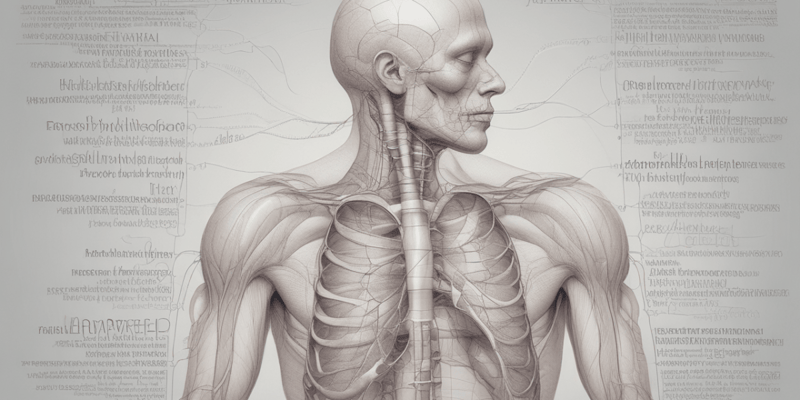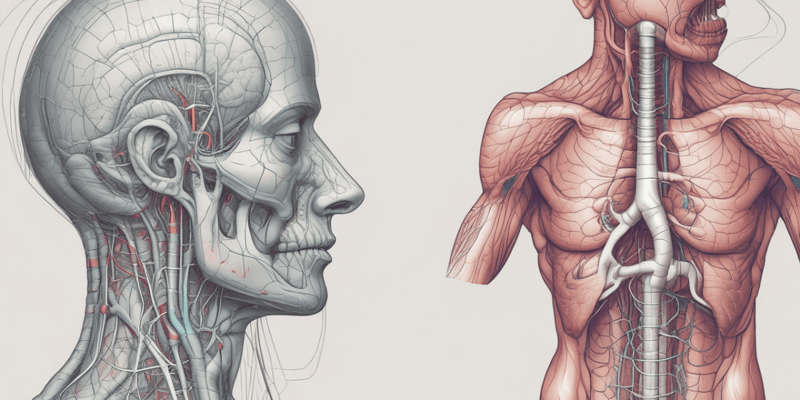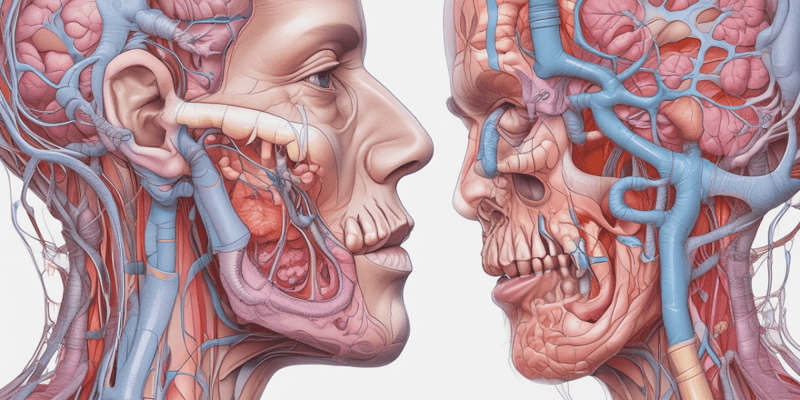60 Questions
What is the term for the inner space within a tubular organ?
Lumen
What is the singular form of the term for the tiny air sacs where gas exchange occurs in the lungs?
Alveolus
What is the term for the small hair-like projections from the cell membrane?
Cilia
What is the term for the indentation in an organ where blood vessels, ducts, etc. enter or leave the organ?
Hilus
What is the term that pertains to the lungs?
Pulmonary
What is the plural form of the term referring to the airways that branch off from the trachea?
Bronchi
What is the function of the alveoli in the lungs?
To facilitate gas exchange between the air and blood
What is the term for the passage through which air enters the lungs?
Lumen
What is the location where blood vessels and ducts enter or leave the lung?
Hilus
What is the purpose of the cilia in the respiratory system?
To move mucus and debris out of the airways
The hilum is the location where bronchi enter the lungs.
True
Cilia are responsible for bringing oxygen into the lungs.
False
The bronchus is the plural form of the term referring to the airways that branch off from the trachea.
False
Alveoli are the smallest airways in the lungs.
False
The lumen of the bronchi is responsible for gas exchange in the lungs.
False
What is a primary function of the respiratory system?
To provide oxygen to the tissues
Which of the following is a non-respiratory function of the respiratory system?
Regulation of body temperature
What is the name of the nerve responsible for the sense of smell?
Olfactory nerve
What is the term for the production of sound through the vocal cords?
Vocalisation
Which of the following is NOT a function of the respiratory system?
Production of hormones
What is the primary function of the respiratory system?
To provide oxygen to and remove carbon dioxide from the tissues
What is the role of the olfactory nerve in the respiratory system?
To facilitate the sense of smell
Which of the following is a non-respiratory function of the respiratory system?
Regulation of body temperature
What is the purpose of counter-current heat exchange in the respiratory system?
To retain heat through counter-current heat exchange
What is the role of the vocal cords in the respiratory system?
To produce sound through vocalisation
The respiratory system provides oxygen to the brain and removes carbon dioxide from the tissues.
True
Thermoregulation is a respiratory function of the respiratory system.
False
Vocalisation via vocal cords in the larynx is a non-respiratory function of the respiratory system.
True
The olfactory nerve is responsible for taste.
False
Counter-current heat exchange is used to lose heat.
False
Match the following functions with their corresponding respiratory system components:
Vocalisation = Vocal cords in the larynx Olfaction = Olfactory nerve Thermoregulation = Panting and counter-current heat exchange Respiratory function = Lungs
Match the following respiratory system components with their functions:
Vocal cords = Vocalisation Olfactory nerve = Smell Lungs = Gas exchange Trachea = Air passage
Match the following terms with their functions in the respiratory system:
Panting = Lose heat Counter-current heat exchange = Retain heat Olfactory nerve = Smell Vocal cords = Sound production
Match the following components with their corresponding functions in the respiratory system:
Larynx = Sound production Olfactory nerve = Smell sensing Lungs = Gas exchange Trachea = Air passage
Match the following functions with their corresponding respiratory system processes:
Remove carbon dioxide = Gas exchange Provide oxygen = Gas exchange Produce sound = Vocalisation Regulate temperature = Thermoregulation
What is the primary function of the respiratory system?
To provide oxygen and remove carbon dioxide from the tissues
Which of the following is NOT a respiratory function of the respiratory system?
Providing oxygen to the tissues
What is the role of counter-current heat exchange in the respiratory system?
To help regulate body temperature
What is the role of the olfactory nerve in the respiratory system?
To facilitate olfaction
What is the role of the vocal cords in the respiratory system?
To produce sound through vocalisation
Why is it important to divide the respiratory system into upper and lower?
To distinguish between different diseases and their treatments
What is the main difference between Kennel cough and asthma?
The location of the infection in the respiratory system
Why is it especially important to distinguish between upper and lower respiratory diseases in emergency situations?
To reduce the risk of misdiagnosis
How do the Delta and Omicron variants of COVID-19 differ in their respiratory infections?
Delta infects the lower respiratory tract, while Omicron infects the upper respiratory tract
Why is it necessary to differentiate between different respiratory diseases, such as Kennel cough and asthma?
To develop an effective treatment plan
What is the main reason to distinguish between upper and lower respiratory diseases?
To differentiate between similar clinical signs
What is the difference between the Delta and Omicron variants of COVID-19?
Delta affects the lower respiratory tract, while Omicron affects the upper respiratory tract
Why is it especially important to differentiate between upper and lower respiratory diseases in emergency situations?
To ensure correct treatment
What is the main difference between Kennel cough and asthma?
Kennel cough affects dogs, while asthma affects humans
Why is it important to divide the respiratory system into upper and lower?
To differentiate between various diseases and provide correct treatment
What is the primary reason for dividing the respiratory system into upper and lower?
To differentiate between various diseases and their corresponding treatments
Why is it especially important to distinguish between upper and lower respiratory diseases in emergency situations?
Because different treatments are required for different diseases
What is the main difference between the Delta and Omicron variants of COVID-19?
The Delta variant affects the lower respiratory tract, while the Omicron variant affects the upper respiratory tract
Why is it necessary to differentiate between Kennel cough and asthma?
Because they require different treatments
What is a key consequence of not distinguishing between upper and lower respiratory diseases?
Misdiagnosis and incorrect treatment
The upper respiratory tract is more commonly affected by COVID-19.
False
The symptoms of Kennel cough and asthma are identical.
False
Differentiating between upper and lower respiratory diseases is only important in non-emergency situations.
False
The treatments for upper and lower respiratory diseases are the same.
False
The respiratory system is divided into upper and lower parts to distinguish between different clinical signs.
True
Study Notes
Respiratory Anatomy
- The term "pulmonary" refers to the lungs
- Bronchi are airway tubes that branch from the trachea, with "bronchi" being the plural form and "bronchus" being the singular form
- Alveoli are small air sacs where gas exchange occurs, with "alveoli" being the plural form and "alveolus" being the singular form
- The lumen is the inner space within a tubular organ, such as the bronchi, and can be thought of as an "opening" or cavity
- The hilus or hilum is an indentation in an organ, including the lung, kidney, and spleen, where blood vessels, ducts, and other structures enter or leave the organ
- Cilia are small hair-like projections that extend from the cell membrane, playing a role in the respiratory system
Respiratory Anatomy
- The term "pulmonary" refers to the lungs
- Bronchi are airway tubes that branch from the trachea, with "bronchi" being the plural form and "bronchus" being the singular form
- Alveoli are small air sacs where gas exchange occurs, with "alveoli" being the plural form and "alveolus" being the singular form
- The lumen is the inner space within a tubular organ, such as the bronchi, and can be thought of as an "opening" or cavity
- The hilus or hilum is an indentation in an organ, including the lung, kidney, and spleen, where blood vessels, ducts, and other structures enter or leave the organ
- Cilia are small hair-like projections that extend from the cell membrane, playing a role in the respiratory system
Respiratory Anatomy
- The term "pulmonary" refers to the lungs
- Bronchi are airway tubes that branch from the trachea, with "bronchi" being the plural form and "bronchus" being the singular form
- Alveoli are small air sacs where gas exchange occurs, with "alveoli" being the plural form and "alveolus" being the singular form
- The lumen is the inner space within a tubular organ, such as the bronchi, and can be thought of as an "opening" or cavity
- The hilus or hilum is an indentation in an organ, including the lung, kidney, and spleen, where blood vessels, ducts, and other structures enter or leave the organ
- Cilia are small hair-like projections that extend from the cell membrane, playing a role in the respiratory system
Respiratory System Functions
- The primary respiratory function is to provide oxygen (O2) to and remove carbon dioxide (CO2) from tissues
Non-Respiratory Functions
- Vocalisation occurs via vocal cords in the larynx
- Thermoregulation (temperature regulation) is performed through panting to lose heat and counter-current heat exchange to retain heat
- Olfaction (smell) is facilitated by the olfactory nerve, which has a close association with the nasal cavity
Respiratory System Functions
- The primary respiratory function is to provide oxygen (O2) to and remove carbon dioxide (CO2) from tissues
Non-Respiratory Functions
- Vocalisation occurs via vocal cords in the larynx
- Thermoregulation (temperature regulation) is performed through panting to lose heat and counter-current heat exchange to retain heat
- Olfaction (smell) is facilitated by the olfactory nerve, which has a close association with the nasal cavity
Respiratory System Functions
- The primary respiratory function is to provide oxygen (O2) to and remove carbon dioxide (CO2) from tissues
Non-Respiratory Functions
- Vocalisation occurs via vocal cords in the larynx
- Thermoregulation (temperature regulation) is performed through panting to lose heat and counter-current heat exchange to retain heat
- Olfaction (smell) is facilitated by the olfactory nerve, which has a close association with the nasal cavity
Respiratory System Functions
- The primary respiratory function is to provide oxygen (O2) to and remove carbon dioxide (CO2) from tissues
Non-Respiratory Functions
- Vocalisation occurs via vocal cords in the larynx
- Thermoregulation (temperature regulation) is performed through panting to lose heat and counter-current heat exchange to retain heat
- Olfaction (smell) is facilitated by the olfactory nerve, which has a close association with the nasal cavity
Respiratory Function
- Provides oxygen (O2) to the tissues
- Removes carbon dioxide (CO2) from the tissues
Non-Respiratory Functions
- Enables vocalisation via vocal cords in the larynx
- Helps regulate body temperature through:
- Panting to lose heat
- Counter-current heat exchange to retain heat
- Facilitates olfaction (smell) through the close association of the olfactory nerve with the nasal cavity
Dividing the Respiratory System into Upper and Lower
- Dividing the respiratory system into upper and lower is crucial for accurate diagnosis and treatment of diseases.
- Different diseases affect different parts of the respiratory system, leading to distinct clinical signs and requiring specific tests and treatments.
Upper Respiratory Tract
- Infections like Kennel cough (in dogs) and cat flu (in cats) primarily affect the upper respiratory tract.
- Omicron variant of COVID-19 tends to infect the upper respiratory tract.
Lower Respiratory Tract
- Diseases like asthma and pulmonary oedema (fluid in the lungs causing cough) affect the lower respiratory tract.
- Pulmonary oedema is a serious condition that can be life-threatening in emergency situations.
- Delta variant of COVID-19 tends to infect the lower respiratory tract.
Importance of Accurate Diagnosis
- Accurate diagnosis of the affected respiratory tract region is critical in emergency situations to ensure proper treatment and prevent mismanagement of diseases.
Dividing the Respiratory System into Upper and Lower
- Dividing the respiratory system into upper and lower is crucial for accurate diagnosis and treatment of diseases.
- Different diseases affect different parts of the respiratory system, leading to distinct clinical signs and requiring specific tests and treatments.
Upper Respiratory Tract
- Infections like Kennel cough (in dogs) and cat flu (in cats) primarily affect the upper respiratory tract.
- Omicron variant of COVID-19 tends to infect the upper respiratory tract.
Lower Respiratory Tract
- Diseases like asthma and pulmonary oedema (fluid in the lungs causing cough) affect the lower respiratory tract.
- Pulmonary oedema is a serious condition that can be life-threatening in emergency situations.
- Delta variant of COVID-19 tends to infect the lower respiratory tract.
Importance of Accurate Diagnosis
- Accurate diagnosis of the affected respiratory tract region is critical in emergency situations to ensure proper treatment and prevent mismanagement of diseases.
Dividing the Respiratory System into Upper and Lower
- Dividing the respiratory system into upper and lower is crucial for accurate diagnosis and treatment of diseases.
- Different diseases affect different parts of the respiratory system, leading to distinct clinical signs and requiring specific tests and treatments.
Upper Respiratory Tract
- Infections like Kennel cough (in dogs) and cat flu (in cats) primarily affect the upper respiratory tract.
- Omicron variant of COVID-19 tends to infect the upper respiratory tract.
Lower Respiratory Tract
- Diseases like asthma and pulmonary oedema (fluid in the lungs causing cough) affect the lower respiratory tract.
- Pulmonary oedema is a serious condition that can be life-threatening in emergency situations.
- Delta variant of COVID-19 tends to infect the lower respiratory tract.
Importance of Accurate Diagnosis
- Accurate diagnosis of the affected respiratory tract region is critical in emergency situations to ensure proper treatment and prevent mismanagement of diseases.
Dividing the Respiratory System into Upper and Lower
- Dividing the respiratory system into upper and lower is crucial for accurate diagnosis and treatment of diseases.
- Different diseases affect different parts of the respiratory system, leading to distinct clinical signs and requiring specific tests and treatments.
Upper Respiratory Tract
- Infections like Kennel cough (in dogs) and cat flu (in cats) primarily affect the upper respiratory tract.
- Omicron variant of COVID-19 tends to infect the upper respiratory tract.
Lower Respiratory Tract
- Diseases like asthma and pulmonary oedema (fluid in the lungs causing cough) affect the lower respiratory tract.
- Pulmonary oedema is a serious condition that can be life-threatening in emergency situations.
- Delta variant of COVID-19 tends to infect the lower respiratory tract.
Importance of Accurate Diagnosis
- Accurate diagnosis of the affected respiratory tract region is critical in emergency situations to ensure proper treatment and prevent mismanagement of diseases.
Test your knowledge of respiratory anatomy, covering terms like bronchi, alveoli, lumen, hilus, and cilia. Learn the differences between plural and singular forms and more!
Make Your Own Quizzes and Flashcards
Convert your notes into interactive study material.
Get started for free




